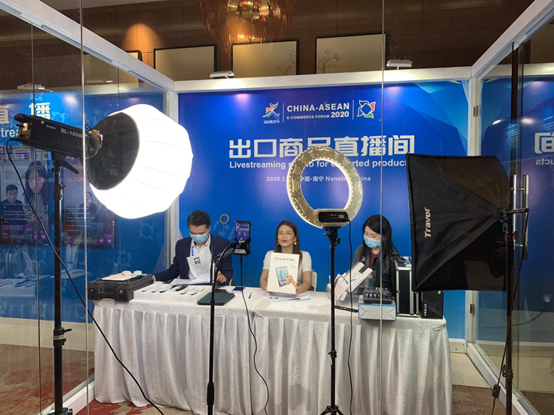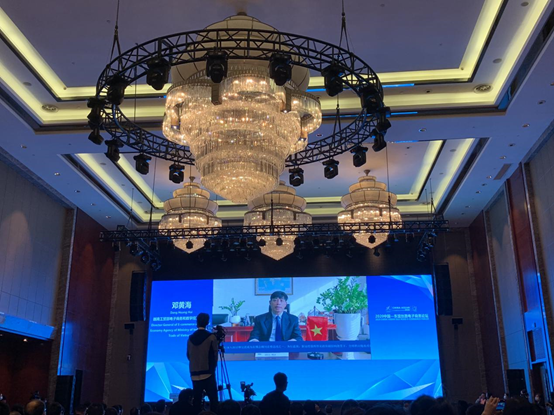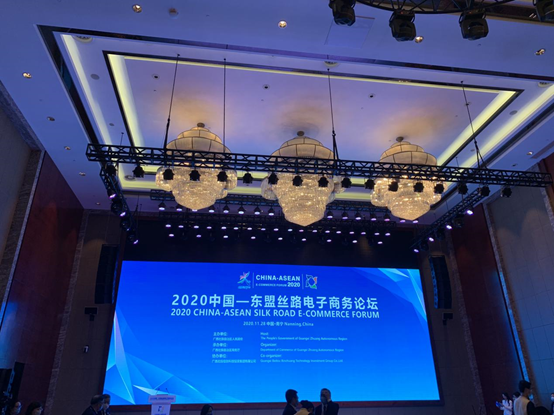

(Written by Guan Qiuyun / Translated by Mo Tingting)Themed with “New Opportunities of E-commerce Energize New Development Pattern of Dual Circulation”, the 2020 China-ASEAN Silk Road E-commerce Forum under the framework of the 17th CAEXPO was successfully held in Nanning, Guangxi on November 28, 2020. Under the COVID-19 pandemic, new forms of E-commerce have helped enterprises as well as the whole industrial chain recover, which signifies the extraordinary strength and resilience of new forms of E-commerce.
As China opens wider to the outside world and unceasingly deepens the Belt and Road construction, cross-border E-commerce as a new international trade pattern is injecting more powerful momentum for global trade development. It is of significance in such a special year to invite state leaders, seniors officials, experts, scholars and elites from China and ASEAN countries in the field of E-commerce to discuss the new development pattern of dual circulation in domestic and international trade.
The new trend of cross-border E-commerce in China-ASEAN region
Since 2020 marks the China-ASEAN Year of Digital Economy Cooperation, as well as the 10th anniversary of the completion of the CAFTA, China and ASEAN will make full use of the physical+on-line CAEXPO, and RCEP, to help pool resources in terms of operation, logistics, finance and talents for cross-border E-commerce platforms, form a new development pattern of dual circulation in domestic and international trade and with the domestic circulation as the core.

Cross-border E-commerce is becoming a new engine for driving China-ASEAN trade. In recent years, Alibaba, JD.com and other Chinese mainstream E-commerce companies have increased their investment in ASEAN E-commerce, payment and other enterprises through acquisition and shareholding, so as to drive the development of relevant industries in ASEAN countries and promote innovation on multilateral cross-border E-commerce.
Facing the challenges brought by the COVID-19, it is the right time for ASEAN countries to strengthen E-commerce cooperation with China via online trade, and to help more products enter the Chinese market.
Statistics showed that the global online retail sales from January to October 2020 reached RMB 9.13 trillion yuan, with a year-on-year growth of 10.9%. Zhu Lian, Director of Department of Electronic Commerce and Information Technology of China’s Ministry of Commerce said China has established the bilateral cooperation mechanism of “Silk Road E-commerce” with 22 countries in five continents, including Vietnam and Cambodia, and carried out multilateral dialogue between government and enterprises, and enterprise exchange activities under the framework. Many specialty products such as Thailand’s coconut, Malaysia’s Musang King durian, and Myanmar’s mango are directly accessible to Chinese consumers through cross-border E-commerce platforms.
Lazada helps the dual circulation of E-commerce trade
Lazada, one of the largest online shopping websites in Southeast Asia, has been actively building a super engine of China-ASEAN import and export in recent years. On the one hand, it helps domestic merchants “go out”, on the other hand, it helps Southeast Asian brands “bring in”, and contributes to the sustainable development of regional digital economic cooperation. In June 2020, Lazada’s first Cross-Border E-commerce Innovation Service Center was officially launched in Nanning. So far, the center has incubated more than 400 small and medium-sized cross-border sellers and provided professional live streaming services for more than 6,000 merchant stores. Through the center, Lazada has built a relatively complete cross-border E-commerce industry chain between China and ASEAN.
Lazada, a local E-commerce company in Southeast Asia, is upgrading its capabilities for import and export, according to Yi Qian, general manager of cross-border business. Over the past few years, more than 4,000 domestic brands have entered the ASEAN market, while more and more Southeast Asian brands have entered China through Lazada. In Malaysia, the electronic customs system of “second-level clearance” has saved about 30 million hours of customs clearance time for small enterprises in just half a year.
Lazada has gained sufficient support in the process of promoting Chinese domestic brands to go abroad: It jointly launched the “New Plan for Chinese Goods to Go Abroad” with Tmall to create a fast track from TMall to LazMall. The entry speed of domestic brands into Lazada brand mall has been shortened from one month to one week. Domestic brands such as Phoenix, Konka, Xtep, Romas and Perfect Diary have settled successively. Just in the past “Double 11” festival, Phoenix bicycle enjoyed booming trade in the Southeast Asian market, and the turnover reached 20 times the usual level. The average daily trade growth rate of Konka is ten times; Perfect Diary, a beauty brand, is popular among consumers in Southeast Asia and has become the Top 1 cross-border beauty brand in sales.
A large number of domestic brands in Southeast Asia also enjoyed a strong sales growth through Lazada’s “Sell to China” program. According to the data, the Philippine beauty brand Sunnies Face rose to become one of the three new lip gloss brands in the first three months after its debut on Tmall. In 2020, the sales volume of “Double 11” increased nearly five times compared with the same period of last year. Ellips, an Indonesian haircare brand, and Irvins, a Singaporean salted egg and sweet potato chip brand, which participated in the “Double 11” activity on Tmall for the first time, saw sales volume more than 50 times on November 11.

With the construction of Lazada import and export super engine, it is believed that China-ASEAN will add infrastructure to the digital economy, help the sustainable development of bilateral digital economy cooperation, and foster more new driving forces for the economic and social development of both sides.
China-ASEAN E-commerce Silk Road will be promising
After more than 10 years of cooperation and development, bilateral trade between China and ASEAN has become a common occurrence. However, the bilateral ties in E-commerce are still in the stage of an urgent need to take off. Facing the huge potential of the trade market between China and ASEAN, the development of cross-border E-commerce is immeasurable and will become a key factor affecting the economic development of ASEAN.
In the future, China will join hands with ASEAN countries to continue the Silk Road E-commerce cooperation and make continuous efforts to improve the quality and level of bilateral economic and trade cooperation.

When talking about the future development of China-ASEAN E-commerce cooperation, Zhu Lian put forward four effective suggestions: First, to establish a bilateral E-commerce cooperation mechanism to lay a solid foundation for the further development of Silk Road E-commerce cooperation; Second, more ASEAN countries should carry out exchanges of E-commerce development plans, policies, regulations, rules and standards, so as to create a favorable environment for the common prosperity and development of E-commerce. Third, efforts should be made to carry out more practical cooperation with E-commerce enterprises in ASEAN countries to open broader space for further development of bilateral economic and trade cooperation. Fourth, we will promote exchanges and cooperation between E-commerce experts and scholars, intermediary agencies and universities to provide intellectual support for China-ASEAN E-commerce cooperation.
The rise and development of E-commerce will inevitably lead to the adjustment and optimization of China-ASEAN economic structure, promote the overall economic development of both sides, create more economic benefits, and provide good opportunities for countries to change the traditional foreign trade model and create a large number of new jobs.
Source: China-ASEAN Panorama
桂ICP备14000177号 Copyright@2006-2013 Guangxi China-ASEAN Panorama Magazine Agency Co., Ltd. All Rights Reserved